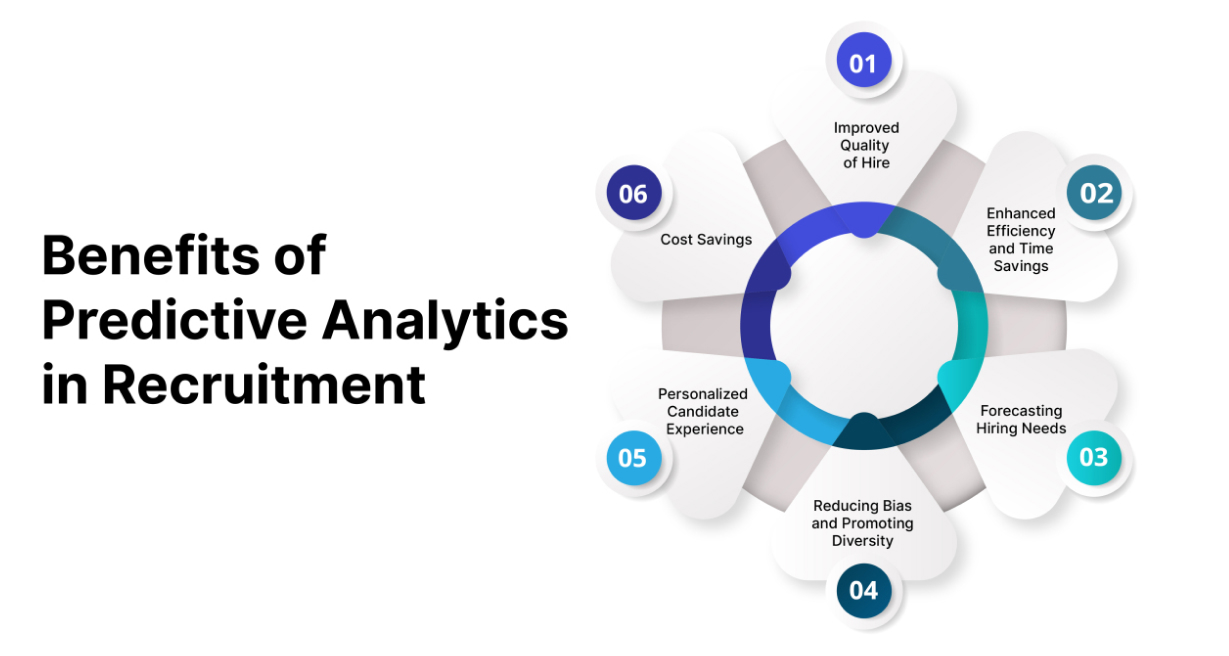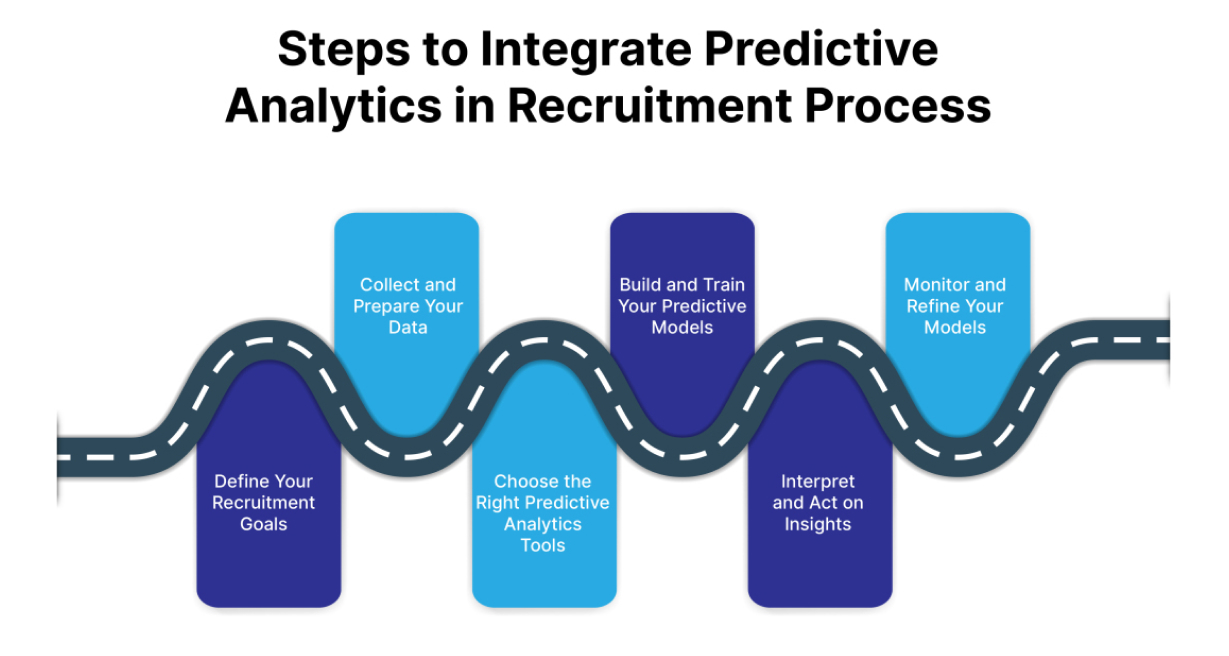
Today, organizations are constantly seeking ways to improve their hiring processes. One of the most effective methods to achieve this is through predictive analytics. By leveraging data-driven insights, predictive analytics can help organizations identify the best candidates, streamline recruitment, and ultimately enhance the overall hiring process. This article will explore the role of predictive analytics in recruitment, its benefits, and practical steps to implement it effectively.
Predictive analytics involves using historical data, statistical algorithms, and machine learning techniques to forecast future outcomes. In the context of recruitment, it means analyzing past hiring data to predict which candidates are most likely to succeed in specific roles. This approach allows organizations to make informed, data-driven decisions rather than relying solely on intuition or gut feelings.
Predictive analytics can analyze various data points, including candidate resumes, interview performance, and employee turnover rates. By identifying patterns and trends, organizations can gain valuable insights into candidate behavior, performance, and retention, ultimately leading to better hiring decisions. For instance, companies like ChinaMobile have used predictive analytics to evaluate technical skills and cultural fit, achieving an 86% reduction in hiring time and a 40% saving in costs.
Implementing predictive analytics in your recruitment process offers a multitude of benefits that can transform the way you attract, hire, and retain top talent. Let's explore some of the key advantages:

One of the primary goals of any recruitment process is to identify and hire the best candidates for the job. Predictive analytics enables recruiters to analyze candidate data, such as skills, experience, and performance metrics, to determine which individuals are most likely to succeed in a given role.
By identifying the right fit for each position, organizations can significantly improve the quality of their hires, leading to increased productivity, job satisfaction, and retention rates. For example, Wells Fargo utilized predictive analytics to assess over two million candidates, resulting in a 15% improvement in teller retention and a 12% improvement in personal banker retention.
The traditional recruitment process can be time-consuming and resource-intensive, often involving manual screening of resumes, countless interviews, and subjective decision-making. Predictive analytics streamlines this process by automating tasks such as resume screening, candidate ranking, and initial assessments.
By leveraging AI-powered tools, recruiters can quickly identify the most promising candidates, reducing time-to-hire and allowing them to focus on higher-value activities, such as engaging with top talent and building relationships. This efficiency is evident in cases like Unilever, which saved 70,000 labor hours through AI-driven predictive analytics in its recruitment process.
One of the most significant advantages of predictive analytics in recruitment is its ability to forecast hiring needs accurately. By analyzing historical data, business projections, and market trends, organizations can anticipate their future staffing requirements and proactively plan their recruitment strategies. This proactive approach enables recruiters to stay ahead of the curve, ensuring they have the right talent in place when needed, minimizing the risk of understaffing or overstaffing.
Unconscious bias can often creep into the recruitment process, leading to unfair and subjective decision-making. Predictive analytics help mitigate this bias by relying on objective data and algorithms to assess candidate's suitability. By removing human prejudices from the equation, organizations can promote diversity and inclusion in their workforce, ensuring that all candidates are evaluated based on their merits and potential, regardless of their background or demographics.
However, it’s critical to ensure data integrity, as inaccurate data can lead to misleading predictions, a challenge noted in talent management where 30 to 50 percent of candidates cheat in online assessments for entry-level jobs, and even 10% of senior candidates have been caught cheating.
Providing a positive and engaging candidate experience is crucial for attracting top talent. Predictive analytics enables recruiters to personalize the recruitment journey for each candidate, tailoring communication, recommendations, and job offers based on individual preferences and behavior. By leveraging data insights, organizations can create a seamless and targeted candidate experience, improving their employer brand and increasing the likelihood of securing the best talent.
Recruitment can be a costly endeavor, with expenses ranging from job advertising to candidate assessments and onboarding. Predictive analytics helps organizations optimize their recruitment budget by identifying the most effective channels for sourcing candidates, reducing the reliance on external agencies, and minimizing the cost of bad hires.
By making data-driven decisions and targeting the right candidates from the start, organizations can significantly reduce their overall recruitment costs while still achieving their hiring goals. Notably, a wrong hire can be costly, with Forbes indicating that it can cost a company around 30% of an employee’s salary.
Now that we've explored the benefits of predictive analytics in recruitment, let's dive into the practical steps you can take to integrate this technology into your hiring process.

The first step in implementing predictive analytics is to identify your recruitment objectives.
Clearly defining your goals will help you determine which data points to collect and analyze, ensuring that your predictive analytics efforts are aligned with your overall recruitment strategy. For instance, businesses focusing on retention have seen up to a 25% decrease in turnover rates by implementing predictive analytics.
To harness the power of predictive analytics, you need access to relevant and high-quality data. Start by identifying data sources that can provide insights into your recruitment process, such as applicant tracking systems (ATS), candidate resumes, job descriptions, performance metrics, and employee feedback. Ensure that your data is clean, consistent, and properly structured to facilitate accurate analysis.
There are various predictive analytics tools and platforms available in the market, each with its own strengths and capabilities. When selecting a tool, consider factors such as ease of use, integration with your existing HR systems, scalability, and the specific features that align with your recruitment goals.
Look for tools that offer robust data visualization, machine learning capabilities, and customizable dashboards to help you derive meaningful insights from your data. Notably, 82% of companies use pre-employment assessments as reliable indicators of a candidate’s skills and potential, highlighting the importance of choosing effective tools.
Once you have your data and tools in place, it's time to build and train your predictive models. This involves selecting the appropriate algorithms and techniques based on your recruitment objectives. For example, if you aim to predict candidate performance, you might use regression analysis or decision trees. If you want to identify the most suitable candidates for a specific role, you could employ clustering or classification algorithms. Work with data scientists or HR analytics experts to develop and fine-tune your models, ensuring they are accurate and reliable.
Predictive analytics is only valuable if you can translate the insights into actionable steps. Regularly review the outputs of your predictive models and use them to inform your recruitment decisions. For instance, if your model identifies a particular set of skills or experiences that are strongly correlated with success in a specific role, you can adjust your job descriptions and candidate screening criteria accordingly. If your model predicts a high attrition rate for certain positions, you can proactively develop retention strategies to mitigate the risk of losing top talent.
Predictive analytics is an iterative process that requires continuous monitoring and refinement. As your recruitment needs evolve and new data becomes available, it's essential to update and optimize your predictive models regularly. Track the performance of your models against your defined KPIs and make adjustments as necessary. Seek feedback from hiring managers, recruiters, and candidates to identify areas for improvement and ensure that your predictive analytics efforts are delivering tangible results.
While predictive analytics offers immense potential for transforming recruitment, it's important to be aware of the challenges and ethical considerations associated with this technology.
Small and mid-sized companies can adopt predictive analytics without large budgets by starting with cost-effective solutions. Open-source tools like R or Python with libraries such as scikit-learn can analyze existing HR data at minimal cost. These companies can leverage data already collected in their applicant tracking systems (ATS) or employee performance records, focusing on key metrics like time-to-hire or retention rates.
Partnering with affordable cloud-based platforms that offer free trials or scalable pricing models can also provide access to predictive analytics capabilities, allowing smaller organizations to test and refine models incrementally before committing to larger investments.
Predictive analytics relies on the collection and analysis of sensitive candidate data, which raises concerns about privacy and security. Organizations must ensure that they have robust data protection measures in place, complying with relevant regulations such as GDPR and HIPAA. It's crucial to obtain candidate consent, maintain transparency about data usage, and implement strict access controls to safeguard personal information.
Although predictive analytics can help reduce unconscious bias in recruitment, it's important to recognize that algorithms are only as unbiased as the data they are trained on. If historical data contains biases or underrepresentation of certain groups, predictive models may perpetuate these biases. To mitigate this risk, organizations should regularly audit their data and models for fairness, ensuring that they are not inadvertently discriminating against any particular group.
Predictive models can sometimes be complex and opaque, making it difficult to understand how they arrive at certain decisions. This lack of interpretability can raise concerns about the fairness and accountability of the recruitment process. To address this challenge, organizations should strive for explainable AI, using techniques that provide insights into the factors influencing the model's predictions. This transparency helps build trust and allows recruiters to make informed decisions based on the model's outputs.
While predictive analytics can automate and streamline various aspects of recruitment, it's essential to remember that it should complement, rather than replace, human judgment. Recruiters and hiring managers should use the insights generated by predictive models as a guide, but ultimately rely on their expertise and instincts to make final hiring decisions.
Maintaining a balance between data-driven insights and human intuition is key to ensuring a fair and effective recruitment process.
The world of recruitment is constantly evolving, with new trends, technologies, and candidate expectations emerging regularly. To stay ahead of the curve, organizations must embrace a culture of continuous learning and adaptation. This involves staying up-to-date with the latest developments in predictive analytics, regularly reviewing and refining recruitment strategies, and being open to feedback and improvement. By fostering a learning mindset and a willingness to adapt, organizations can harness the full potential of predictive analytics in recruitment.
To illustrate the transformative power of predictive analytics in recruitment, let's explore some real-world examples and success stories:
Unilever, a global consumer goods company, implemented predictive analytics to streamline its graduate recruitment process. By analyzing candidate data, including resumes, assessments, and video interviews, Unilever's predictive models identified the most promising candidates, reducing time-to-hire by 75% and saving significant recruitment costs.
The company also reported improved diversity and candidate experience, with 80% of candidates expressing satisfaction with the hiring process.
Hilton, a leading hospitality company, leveraged predictive analytics to identify candidates who were most likely to succeed in customer-facing roles. By analyzing data from assessments, interviews, and performance metrics, Hilton's predictive models helped the company reduce attrition rates by 38% and improve the quality of hires. The company also reported increased efficiency in the recruitment process, with a 35% reduction in time-to-fill for key positions.
These success stories demonstrate the tangible benefits that organizations can achieve by embracing predictive analytics in their recruitment processes. From improving the quality of hires to reducing time-to-fill and optimizing recruitment costs, predictive analytics has the potential to transform the way organizations attract, hire, and retain top talent.
Predictive analytics has the potential to revolutionize recruitment by transforming how organizations identify, evaluate, and hire talent. By leveraging data-driven insights, companies can streamline their hiring processes, reduce bias, and improve the overall quality of hires. However, it’s essential to approach predictive analytics with a focus on ethical considerations and human judgment.
As organizations continue to embrace AI in HR and predictive analytics, they will be better equipped to navigate the complexities of the modern job market. By implementing predictive analytics effectively, companies can strengthen their hiring processes and build high-performing teams that drive business success.
The future of recruitment lies in the ability to harness the power of data. By adopting predictive analytics, organizations can not only enhance their hiring processes but also create a more inclusive and effective workforce.

CredBadge™ is a proprietary, secure, digital badging platform that provides for seamless authentication and verification of credentials across digital media worldwide.
CredBadge™ powered credentials ensure that professionals can showcase and verify their qualifications and credentials across all digital platforms, and at any time, across the planet.

Please enter the License Number/Unique Credential Code of the certificant. Results will be displayed if the person holds an active credential from TMI.